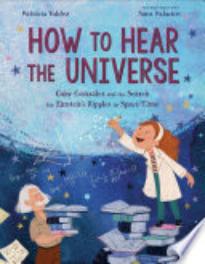2018 School Spending Survey Report
How to Hear the Universe: Gaby González and the Search for Einstein’s Ripples in Space-Time
Knopf.
Mar. 2022.
40p.
Tr $17.99. ISBN 9781984894595.
COPY ISBN
 Gr 1-4–Albert Einstein published his theory of general relativity in Germany in 1915, but he could not detect or measure the ripples (gravitational waves) in space-time that he theorized existed. Years later, in Argentina, a young girl named Gabriela (Gaby) González became curious about time, space, and gravity; she went on to study physics, and became part of the team that eventually was able to measure the gravitational waves Einstein had described. This advanced subject matter is presented with clarity and a sense of wonder, making it accessible to a young (often space-obsessed) audience, with additional back matter (time line, glossary, sources, notes) for those who want more detail. Palacios’s illustrations feature recurring motifs of dragonflies, frogs on lily pads, speech bubbles filled with pictures and diagrams, chalkboards full of equations, and five-pointed stars.
Gr 1-4–Albert Einstein published his theory of general relativity in Germany in 1915, but he could not detect or measure the ripples (gravitational waves) in space-time that he theorized existed. Years later, in Argentina, a young girl named Gabriela (Gaby) González became curious about time, space, and gravity; she went on to study physics, and became part of the team that eventually was able to measure the gravitational waves Einstein had described. This advanced subject matter is presented with clarity and a sense of wonder, making it accessible to a young (often space-obsessed) audience, with additional back matter (time line, glossary, sources, notes) for those who want more detail. Palacios’s illustrations feature recurring motifs of dragonflies, frogs on lily pads, speech bubbles filled with pictures and diagrams, chalkboards full of equations, and five-pointed stars.
VERDICT This STEM title is an excellent addition to any public or school library; Gaby González deserves the same recognition as Margaret Mitchell, Katherine Johnson, Grace Hopper, Ada Lovelace, and Mario Molina.
ALREADY A SUBSCRIBER? LOG IN
We are currently offering this content for free. Sign up now to activate your personal profile, where you can save articles for future viewing





Be the first reader to comment.
Comment Policy:
Comment should not be empty !!!